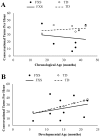A Pilot Quantitative Evaluation of Early Life Language Development in Fragile X Syndrome
- PMID: 30699903
- PMCID: PMC6406320
- DOI: 10.3390/brainsci9020027
A Pilot Quantitative Evaluation of Early Life Language Development in Fragile X Syndrome
Abstract
Language delay and communication deficits are a core characteristic of the fragile X syndrome (FXS) phenotype. To date, the literature examining early language development in FXS is limited potentially due to barriers in language assessment in very young children. The present study is one of the first to examine early language development through vocal production and the language learning environment in infants and toddlers with FXS utilizing an automated vocal analysis system. Child vocalizations, conversational turns, and adult word counts in the home environment were collected and analyzed in a group of nine infants and toddlers with FXS and compared to a typically developing (TD) normative sample. Results suggest infants and toddlers with FXS are exhibiting deficits in their early language skills when compared to their chronological expectations. Despite this, when accounting for overall developmental level, their early language skills appear to be on track. Additionally, FXS caregivers utilize less vocalizations around infants and toddlers with FXS; however, additional research is needed to understand the true gap between FXS caregivers and TD caregivers. These findings provide preliminary information about the early language learning environment and support for the feasibility of utilizing an automated vocal analysis system within the FXS population that could ease data collection and further our understanding of the emergence of language development.
Keywords: automated vocal analysis; fragile X syndrome; language development.
Conflict of interest statement
R.C.S. receives funding from Fulcrum Therapeutics. C.A.E. has received current or past funding from Confluence Pharmaceuticals, Novartis, F. Hoffmann-La Roche Ltd., Seaside Therapeutics, Riovant Sciences, Inc., Fulcrum Therapeutics, Neuren Pharmaceuticals Ltd., Alcobra Pharmaceuticals, Neurotrope, Zynerba Pharmaceuticals, Inc., and Ovid Therapeutics Inc. to consult on trial design or development strategies and/or conduct clinical trials in FXS or other neurodevelopmental disorders. C.A.E. is additionally the inventor or co-inventor on several patents held by Cincinnati Children’s Hospital Medical Center or Indiana University School of Medicine describing methods of treatment in FXS or other neurodevelopmental disorders. E.V.P. has received research support by the National Institutes of Health (NIMH), American Academy of Child and Adolescent Psychiatry, and Cincinnati Children’s Hospital Research Foundation. He is a clinical trial site investigator for the Marcus Autism Center (clinical trial, Autism). He receives compensation for consulting for Proctor & Gamble. He receives book royalties from Springer. There are no conflicts of interest with the current manuscript. K.C.D. has received research support from the National Institute of Neurological Disorders and Stroke (NINDS), American Academy of Child and Adolescent Psychiatry, and Cincinnati Children’s Hospital Medical Center. She is a clinical trial site investigator for F. Hoffman-La Roche Ltd. and Ovid Therapeutics. There are no conflicts of interest for the current manuscript.
Figures



Similar articles
-
Early communication development in infants and toddlers with Fragile X syndrome.Autism Dev Lang Impair. 2022 May 6;7:23969415221099403. doi: 10.1177/23969415221099403. eCollection 2022 Jan-Dec. Autism Dev Lang Impair. 2022. PMID: 36438157 Free PMC article.
-
Language development in infants and toddlers with fragile X syndrome: change over time and the role of attention.Am J Intellect Dev Disabil. 2015 Mar;120(2):125-44. doi: 10.1352/1944-7558-120.2.125. Am J Intellect Dev Disabil. 2015. PMID: 25715182 Free PMC article.
-
Developmental Trajectory of Communication Repair in Children with Fragile X Syndrome.Autism Dev Lang Impair. 2020 Jan-Dec;5:2396941520909014. doi: 10.1177/2396941520909014. Epub 2020 Feb 27. Autism Dev Lang Impair. 2020. PMID: 32704545 Free PMC article.
-
Sensory Processing Phenotypes in Fragile X Syndrome.ASN Neuro. 2018 Jan-Dec;10:1759091418801092. doi: 10.1177/1759091418801092. ASN Neuro. 2018. PMID: 30231625 Free PMC article. Review.
-
New Therapeutic Options for Fragile X Syndrome.Curr Treat Options Neurol. 2019 Feb 27;21(3):12. doi: 10.1007/s11940-019-0551-8. Curr Treat Options Neurol. 2019. PMID: 30809735 Review.
Cited by
-
Communication in fragile X syndrome: Patterns and implications for assessment and intervention.Front Psychol. 2022 Dec 22;13:929379. doi: 10.3389/fpsyg.2022.929379. eCollection 2022. Front Psychol. 2022. PMID: 36619013 Free PMC article. Review.
-
Developmental studies in fragile X syndrome.J Neurodev Disord. 2020 May 2;12(1):13. doi: 10.1186/s11689-020-09310-9. J Neurodev Disord. 2020. PMID: 32359368 Free PMC article. Review.
-
Towards Mechanism-Based Treatments for Fragile X Syndrome.Brain Sci. 2019 Aug 16;9(8):202. doi: 10.3390/brainsci9080202. Brain Sci. 2019. PMID: 31426300 Free PMC article.
-
Bringing the Laboratory Home: PANDABox Telehealth-Based Assessment of Neurodevelopmental Risk in Children.Front Psychol. 2020 Jul 28;11:1634. doi: 10.3389/fpsyg.2020.01634. eCollection 2020. Front Psychol. 2020. PMID: 32849001 Free PMC article.
-
Language nutrition for language health in children with disorders: a scoping review.Pediatr Res. 2020 Jan;87(2):300-308. doi: 10.1038/s41390-019-0551-0. Epub 2019 Aug 27. Pediatr Res. 2020. PMID: 31454828 Free PMC article.
References
-
- Hagerman R.J., Hagerman P.J., editors. Fragile X Syndrome: Diagnosis, Treatment, and Research. 3rd ed. Johns Hopkins Univ. Press; Baltimore, MD, USA: 2002. p. 540.
Grants and funding
LinkOut - more resources
Full Text Sources
Miscellaneous

